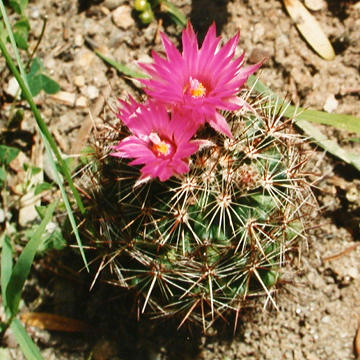

Coryphantha vivipara - (image 1 of 4)
Taxonomy
Family: Cactaceae
Also called Escobaria vivipara (Nutt.) Buxbaum.
Habitat
Dry, grassy plains.
Associates
Distribution
Western MN south to KS and OK, west to Alberta and AZ.
Morphology
Perennial with cylindric, solitary or clumping stems to 30 cm. Tubercles elongate, to 20 mm; areoles slightly woolly; central spines usually 4, with 1 pointing down, 1-2 cm, red throughout or with white at the base; radial spines 12-20, 1 cm long, white; glochids lacking. Flowers magenta-pink, to 4 cm wide, on new growth; hypanthium funnelform. Fruit green, to 2.5 cm, thin-walled. Seeds brown, to 2 mm, wingless.
Notes
Flowers May to August
Wetland indicator: Upland
This is really a western species that is represented by var. vivipara at the most eastern edge of its range in west-central MN. It is extremely cold hardy and is the only pink flowering cactus that I know of that naturally occurs as far north as Canada. This plant is one that I grew in southern NY and it managed to get through an entire winter outdoors and still manage to bloom in the spring. Unfortunately it eventually succumbed to wet weather. Attempting to grow this or other cacti so far north and east requires an extremely well-drained soil. Would probably do quite well in an unheated greenhouse.
References
Gleason, Henry A.
and A. Cronquist. 1991. Manual of Vascular Plants of Northeastern United States
and Adjacent Canada. Second Ed.
The New York Botanical Garden. Bronx, NY
|
Michael Hough © 2010 |